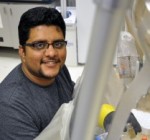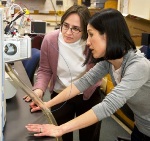An energy-efficient house that can send alerts if its residents are ill has been developed by researchers at the University of Hertfordshire.
Pureti was applied to asphalt and concrete paving near the LSU campus; Professor Hassan is monitoring air quality and groundwater runoff from the site.
With the use of a mercury "fingerprinting" technique, researchers from the University of Michigan, the University of California, Davis, and the San Francisco Estuary Institute have identified the main sources of mercury in bay floor sediments and shown that small fish near the base of the food web acquire their mercury from those sediments.
MBD Energy, owner of three CO2-to-energy projects, will pilot the extraction unit.

The first rough draft of a “genetic road map” of prairie cordgrass, a biomass crop, is giving scientists an inside look at the genes of one of the crops that may help produce the next generation of biofuels.
A new spacing formula based on wind tunnel testing recommends turbines be spaced 15 rotor diameters apart, more than half the current standard.

A University of Alabama graduate student is using Clostidium pasteurianum bacteria to break down a biodiesel waste product and find uses for its byproducts: butanol, propanediol, and ethanol.
The founders of June Energy developed the Emerald, a personal solar panel the size of a paperback, that can be used in developing countries.

The good news is that the dispersant stayed in the deep ocean after it was first applied; the bad news is that it stayed in the deep ocean and did not degrade.
America's wind industry built 5,115 megawatts of wind power last year, barely half of 2009's record pace, but entered 2011 with more than 5,600 megawatts currently under construction -- and with wind cost-competitive with natural gas for new electric generation, utilities are moving to lock in favorable rates.
A Kansas State University scientist is digging deep to solidify information about potential tungsten contamination in the nation's groundwater and aquifers.
To cut down on convoys trucking fuel to forward operating bases, the Office of Naval Research (ONR) and elements within the Marine Corps have successfully demonstrated their goal to reduce petroleum and energy usage in remote locations in Afghanistan.

The Natural Resources Defense Council and Health Care Without Harm say that efforts to block EPA's carbon dioxide pollution actions will result in adverse health consequences.
The Feb. 22 public meeting in Washington, D.C., is part of the Federal Railroad Administration’s review of its steadily increasing approvals for the movement of damaged packages or leaking tank cars that are not in compliance with hazardous materials regulations.

Pacific Northwest National Laboratory's Alla Zelenyuk said the results could have profound implications for policy governing particulate matter.
Founding members are signatories to the Carsharing Industry Code of Ethics and Standards of Practices, which articulates the purpose, definition, and goals of carsharing.
“As PV technology improvements reduce cost faster than conventional technologies reduce cost, the world is likely to soon see an environment where PV subsidies are no longer necessary,” said report author Anthony Pavone.
Hovensa LLC also will pay more than $5.3 million to settle Clean Air Act violations; EPA estimates smog and asthma-causing emissions will be reduced by 8,500 tons per year.
The federal and state agencies will work together on fuel economy and greenhouse gas standards for model year 2017-2025 cars and light-duty trucks.
The company will "operationalize" sustainability, according to Dow chief executive officer Andrew Liveris.